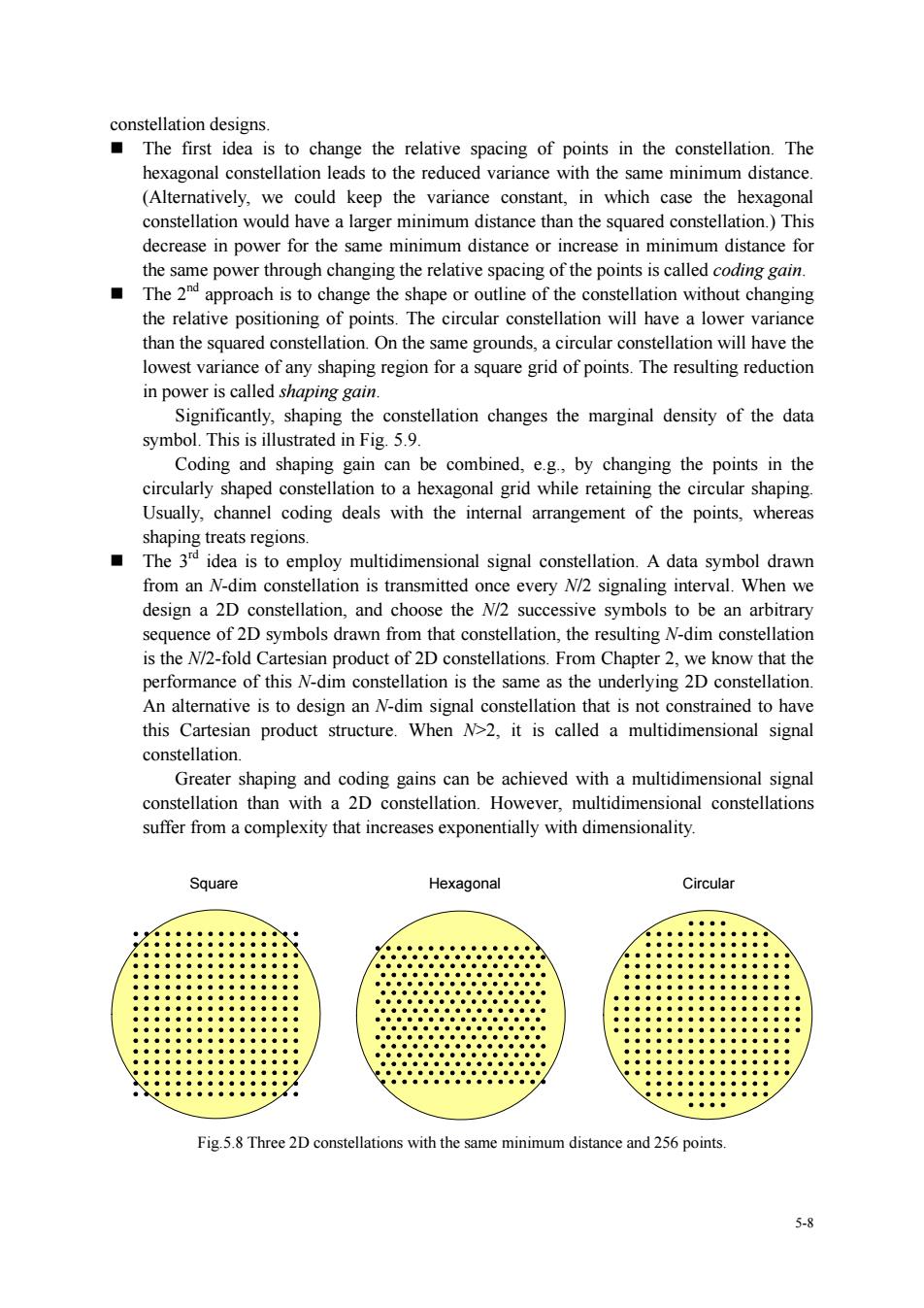正在加载图片...

constellation designs ■The first idea he agonal (Alternatively,we could keep the variance constant,in which case the hexagonal constellation would have a larger minimum distance than the squared constellation.)This decrease in power for the same minimum distance or increase in minimum distance for the same power through changing the relative spacing of the points is called codinggain The 2nd approach is to change the shape or outline of the constellation without changing the relative positioning of points.The circular constellation will have a lower variance than the squared constellation.On the same grounds.a circular constellation will have the lowest variance of any shaping region for a square grid of points.The resulting reduction in power is called shaping gain Significantly,shaping onstellation changes the marginal density of the data symbol This isillustrated in Fig.5.9 Coding and shaping gain can be combined.e.g.by changing the points in the circularly shaped constellation to a hexagonal grid while retaining the circular shaping. Usually,channel coding deals with the internal arrangement of the points,whereas The egions idea is to employ multidimensional signal constellation.A data symbol drawn from an N-dim constellation is transmitted once every N2 signaling interval.When we design a 2D constellation,and choose the N/2 successive symbols to be an arbitrary sequence of 2D symbols drawn from that constellation,the resulting N-dim constellation is the N2-fold Cartesian product of 2D constellations.From Chapter2,we know that the nance of this N-dim tellation is the san as the und erlying2D。 ation llation that is not constrained to have this Cartesian product structure.When N>2,it is called a multidimensional signal constellation. Greater shaping and coding gains can be achieved with a multidimensional signal onstellation than with a 2D constellation.How eve multidim ensional constellations from a complexity that increases exponentially with dimensionality Square Hexagonal Circular Fig 5.8 Three 2D constellations with the same minimum distance and 256 points 5-85-8 constellation designs. The first idea is to change the relative spacing of points in the constellation. The hexagonal constellation leads to the reduced variance with the same minimum distance. (Alternatively, we could keep the variance constant, in which case the hexagonal constellation would have a larger minimum distance than the squared constellation.) This decrease in power for the same minimum distance or increase in minimum distance for the same power through changing the relative spacing of the points is called coding gain. The 2nd approach is to change the shape or outline of the constellation without changing the relative positioning of points. The circular constellation will have a lower variance than the squared constellation. On the same grounds, a circular constellation will have the lowest variance of any shaping region for a square grid of points. The resulting reduction in power is called shaping gain. Significantly, shaping the constellation changes the marginal density of the data symbol. This is illustrated in Fig. 5.9. Coding and shaping gain can be combined, e.g., by changing the points in the circularly shaped constellation to a hexagonal grid while retaining the circular shaping. Usually, channel coding deals with the internal arrangement of the points, whereas shaping treats regions. The 3rd idea is to employ multidimensional signal constellation. A data symbol drawn from an N-dim constellation is transmitted once every N/2 signaling interval. When we design a 2D constellation, and choose the N/2 successive symbols to be an arbitrary sequence of 2D symbols drawn from that constellation, the resulting N-dim constellation is the N/2-fold Cartesian product of 2D constellations. From Chapter 2, we know that the performance of this N-dim constellation is the same as the underlying 2D constellation. An alternative is to design an N-dim signal constellation that is not constrained to have this Cartesian product structure. When N>2, it is called a multidimensional signal constellation. Greater shaping and coding gains can be achieved with a multidimensional signal constellation than with a 2D constellation. However, multidimensional constellations suffer from a complexity that increases exponentially with dimensionality. Square Hexagonal Circular Fig.5.8 Three 2D constellations with the same minimum distance and 256 points